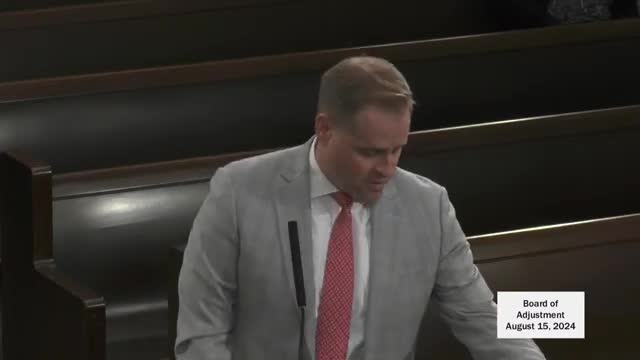Demolition approved for dilapidated structures amid community outcry
August 15, 2024 | Other Public Meetings, Oklahoma City, Oklahoma County, Oklahoma

This article was created by AI summarizing key points discussed. AI makes mistakes, so for full details and context, please refer to the video of the full meeting. Please report any errors so we can fix them. Report an error »

In a recent government meeting, discussions centered around the proposed demolition of two structures in a historic preservation area, raising significant concerns about public safety and historical integrity. The meeting featured presentations from structural engineers and community members, highlighting the deteriorating condition of the buildings and the implications of their potential demolition.
David Box, representing the property owner, outlined the legal framework guiding the demolition process, emphasizing that the structures posed an imminent threat to public health and safety due to their state of decay. He noted that a thorough analysis by licensed structural engineer Tim Johnson confirmed the buildings' unsafe conditions, including severe structural damage and water infiltration. Johnson's report indicated that the main house lacked a proper foundation and exhibited significant movement, while the back structure was built on an inadequate garage slab, further compromising its stability.
Community members voiced strong opposition to the demolition, citing the historical significance of the properties. Tammy Dowell, a local resident, passionately argued that the buildings were part of the neighborhood's heritage, constructed by her family after World War II. She criticized the current property owner for neglecting the structures and urged the board to consider their historical value before making a decision.
David Bigham, president of the Jefferson Park Neighborhood Association, echoed these sentiments, suggesting that the buildings could be restored rather than demolished. He raised concerns about the potential for new construction to be denser than the existing structures, which could alter the character of the neighborhood.
The board members engaged in a detailed discussion about the criteria for demolition, emphasizing the high standards set by the ordinance, which requires clear evidence that no other means could alleviate the safety threat. They acknowledged the challenges of balancing public safety with historical preservation, noting that any new construction would also undergo rigorous review to ensure compatibility with the neighborhood's character.
As the meeting concluded, the board faced the difficult task of weighing the engineers' findings against the community's desire to preserve its historical fabric. The decision on whether to allow the demolition remains pending, with significant implications for both public safety and the preservation of local history.
David Box, representing the property owner, outlined the legal framework guiding the demolition process, emphasizing that the structures posed an imminent threat to public health and safety due to their state of decay. He noted that a thorough analysis by licensed structural engineer Tim Johnson confirmed the buildings' unsafe conditions, including severe structural damage and water infiltration. Johnson's report indicated that the main house lacked a proper foundation and exhibited significant movement, while the back structure was built on an inadequate garage slab, further compromising its stability.
Community members voiced strong opposition to the demolition, citing the historical significance of the properties. Tammy Dowell, a local resident, passionately argued that the buildings were part of the neighborhood's heritage, constructed by her family after World War II. She criticized the current property owner for neglecting the structures and urged the board to consider their historical value before making a decision.
David Bigham, president of the Jefferson Park Neighborhood Association, echoed these sentiments, suggesting that the buildings could be restored rather than demolished. He raised concerns about the potential for new construction to be denser than the existing structures, which could alter the character of the neighborhood.
The board members engaged in a detailed discussion about the criteria for demolition, emphasizing the high standards set by the ordinance, which requires clear evidence that no other means could alleviate the safety threat. They acknowledged the challenges of balancing public safety with historical preservation, noting that any new construction would also undergo rigorous review to ensure compatibility with the neighborhood's character.
As the meeting concluded, the board faced the difficult task of weighing the engineers' findings against the community's desire to preserve its historical fabric. The decision on whether to allow the demolition remains pending, with significant implications for both public safety and the preservation of local history.
View full meeting
This article is based on a recent meeting—watch the full video and explore the complete transcript for deeper insights into the discussion.
View full meeting
